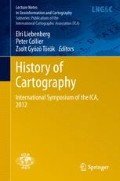Abstract
Large-scale topographic maps were first created in the eighteenth century, but in the beginning their real use was limited to military people. Although forested areas were surveyed and shown on these maps, practically there was no military interest in forested areas. Cadastral mapping or engineering surveys focused on urban and rural areas only. In military training schools, cadets had to study field navigation including distance calculation and map-sketching, and cross-country activities became part of the military training. The civilian interest in sports, including cross-country races also became important at the time of Romanticism. This was an intellectual and artistic movement, which originated in the second half of the eighteenth century. It was also a reaction against the material changes in society, which accompanied the expanding industrial capitalism. According to the Romantics, the solution was to go “back to nature”, because nature was seen as the source of renewal. At the end of the nineteenth century, all the prerequisites for orienteering as a sport (including unclassified topographic maps, at least in some Scandinavian countries and in Britain) were present. It was also the time when the first tourist maps were published; although most used only tracks and paths in the forested areas (originally these tracks and paths were created for forestry or hunting purposes). The development of orienteering maps clearly shows the process of the discovery of forested areas. This paper presents the major milestones of this development in the nineteenth, but mostly in the twentieth century.
Access this chapter
Tax calculation will be finalised at checkout
Purchases are for personal use only
References
Berglia K et al (1987) Orienteringsidretten i Norge gjennom 90 år. Norges Orienteringsforbund, Oslo
Hurtt GC et al (2006) The underpinnings of land-use history: three centuries of global gridded land-use transitions, wood-harvest activity, and resulting secondary lands. Glob Change Biol 12:1208–1229. doi:10.1111/j.1365-2486.2006.01150.x
Myrvold BO (2005) 100 years in the forest—a personal route choice through the history of orienteering. Chapter 2-Dawn. O-Sport 4(1):48–50
Robinson G (1988) The forest and the trees: a guide to excellent forestry. Island Press, Washington, D.C
Scott SP (1982) The visigothic code (forum judicum). Fred B. Rothman & Co. Littleton, Colorado
Spiess E (1972) International genormte topographische Karten für den Orientierungslauf. Int Yearbook Cartography 124–129
Szaflarski J (1959) A map of the Tatra mountains drawn by George Wahlenberg in 1813 as a prototype of the contour-line map. Geogr Ann 41(1):74–82
Zentai L (2009) The use of new technologies in making orienteering maps. Sci Jour Orienteering 17(1):55–63
Acknowledgments
The study was sponsored by the Hungarian Scientific Research Fund (OTKA No. K 100911).
Author information
Authors and Affiliations
Corresponding author
Editor information
Editors and Affiliations
Rights and permissions
Copyright information
© 2014 Springer-Verlag Berlin Heidelberg
About this chapter
Cite this chapter
Zentai, L. (2014). Discovery of Forested Areas on Topographic Maps: Development of Orienteering Maps. In: Liebenberg, E., Collier, P., Török, Z. (eds) History of Cartography. Lecture Notes in Geoinformation and Cartography(). Springer, Berlin, Heidelberg. https://doi.org/10.1007/978-3-642-33317-0_18
Download citation
DOI: https://doi.org/10.1007/978-3-642-33317-0_18
Published:
Publisher Name: Springer, Berlin, Heidelberg
Print ISBN: 978-3-642-33316-3
Online ISBN: 978-3-642-33317-0
eBook Packages: Earth and Environmental ScienceEarth and Environmental Science (R0)

